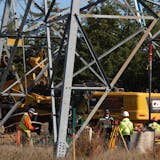In a May 5 commentary ("A run-down river runs through it"), Ron Way talks about the Minnesota River as an "aging natural wonder" and an "aging soldier."
Compared with Ron and I, the river is old. Compared by geologists with the St. Croix and Mississippi Rivers, the Minnesota River is considered young. The other two rivers have eroded down to bedrock in many places, so they have less sediment than the Minnesota. This sediment, which Way accurately describes as rich glacial fill, arrived in Minnesota by glaciers and erosion from Canada. It was, and still is, eroding to the Gulf of Mexico.
Yes, as Way stated, the valley was miles wide and filled to the brim with meltwater. But it was carrying more than just water. Just as we got our soil from these glaciers, parts of southern states and most of Louisiana were formed from Upper Midwest soil carried by rivers on their way to the Gulf. This is why "Minnesota" translates into "sky-tinted" or "cloudy" water, due to the sediment. The same way the Red River got its name from the red clay in that area and in the river. The Blue Earth River got its name, likewise, from the blue clay in its banks and water. All three of these rivers got their names in preagricultural times, when they were eroding naturally, as they still are today. Total sediment going to the Gulf today is less than preagricultural times, and Louisiana is now shrinking. Perception is different from reality. An April 11, 1888 quote in my local paper about Crystal Lake noted that "for the past two years this lake has been little better than a marsh and a very unsightly one at that."
Way wants to blame farmers and tile drainage for the river's problems. But to encourage settlers to come to Minnesota, the government paid for and supported ditches and tiling — to reduce malaria and typhoid fever, to ensure a constant supply of water for navigation, and to grow more crops to feed our expanding nation and the world.
Way asked "Why fertilize already fertile lands?" and argued that a regular crop rotation will nourish the soil. This may be true if you never remove anything. But when crops are removed and eaten and/or fed to animals that are then consumed, the nutrients transferred to human waste need to be replaced if the waste is flushed down the river, or the soil will be depleted. Certainly, using either Way's logic or mine, it would be hard to build a case to use any fertilizer on lawns, parks, etc.
In 1992, Gov. Arne Carlson's effort was to make the Minnesota River fishable and swimmable by 2002. These goals, in many cases, are diametrically opposed. Fish like weeds; swimmers don't. Twenty years and $1 billion to $3 billion later, not much has changed, because the Minnesota Pollution Control Agency thought the erosion was coming from flat farm fields and that if farmers left residue on the fields (which they did), the problem would be solved. This didn't help. Through research, the main source of sediment was proved to be from streambank erosion, not farm fields. Now farmers are being required to put buffers on ditches even though research by David Lobb and Don Flaten in Manitoba and other university researchers are finding that buffers can be a source of dissolved phosphorus (the most usable source for algae) and are highly inefficient when it comes to filtering nutrients. Way said that these buffers soak up nutrients. Well, if they do, what happens to the nutrients over time? Stay there forever? I think not.
The accompanying photograph shows potholes refilled after a moderate rain event in March of this year. This happens many years, and last year it persisted most of the crop year in many counties in south-central Minnesota. "More water storage" is the new catchphrase used to address water problems and a so-called solution for the river. Looking at the photo, how much more water do you want farmers to store, and where would you put it? And if they remain full, where do you put the next rain?
When drained, these depressional areas are able to hold more water to reduce peak flows. When full, the next rain inundates them, worsening surface runoff. This is what commonly happened in the past and created all of our ravines, streams and rivers long before farming. This process has been slowed by terraces, berms, tiling and other farming practices. It has been sped by more rainfall, roads, paved and impervious surfaces, home and building roofs, etc. Agricultural drainage is designed to handle half an inch of rain per day. Roads and storm sewers are designed to handle 2 inches per hour or more. This is 96 times more water per day than ag drainage.


